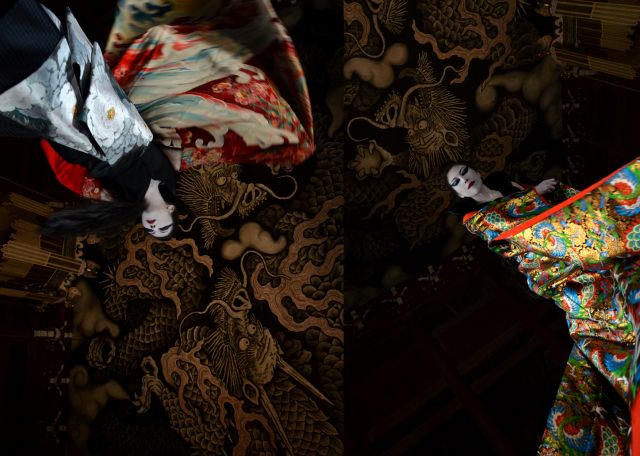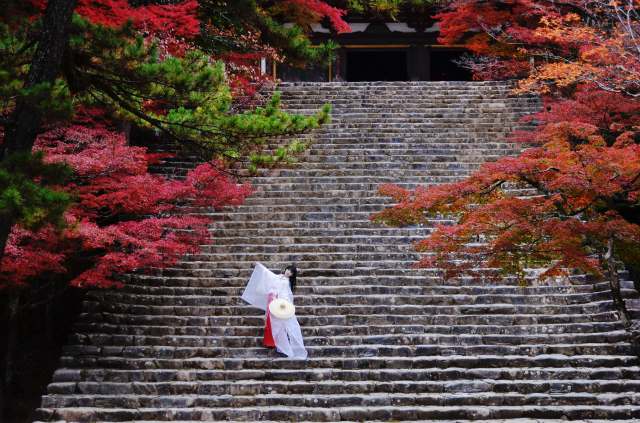The Japonism
- Contents -
<1>"The Japonism" (photo works)
★Nice to know you!
★What is "The Japonism"
★Some of The Pieces
<2>Our workshop "A Window on Japan" (an overseas project with Dr.Terauchi)
★Proposal
★Contact us : diva-ymck@nifty.com
<1>“The Japonism” (photo works)
Nice to Know you
- Naoya Yamaguchi :
- Photographer
- Diva・Unison Co. President
My name is Naoya Yamaguchi, and I am a free agent photographer in Japan.
I usually take publicity photographs of commercials and TV personalities. I have a photograph studio in Tokyo. It is a studio called “Studio☆DIVA” and there are about twenty professional hair and makeup artists and photographers in total. They are all great artists who have trained hard and they are also my precious friends.
I will introduce you some of my lifework pieces in this site. They are from a group of pieces called “The Japonism.” In a word, they express essences of Japanese sense of beauty, emotions, and ideas.
I work as an official photographer for “Miss Japan” and “Miss International,” so they are happy to take parts in my pieces as models. Also, dancers and actors whom I have worked with willingly cooperate with me. Their hair set and makeup are done by artists at “Studio☆DIVA.” It is rather enjoyable time to make creative photo shoots, I think.
As for me, images for the pieces well up from my unconsciousness. I put them in actual pieces by using Japanese traditional cultures and the sense of life of Japanese people, especially emotions of four seasons. Therefore they are not reportorial pieces about Japan, but some deep and clear Japanese essences.
For example, please look at the piece, “Oiran.” There was not an Oiran as beautiful as her in Yoshiwara (a theme park of prostitutes and courtesans) in Edo Era. Also, please take a look at “Greeting of Spring.”There could not have been a moment of an encounter as bright and breathtaking in spring at a mountain village.
In principle, my pieces are all actual photography and not composite. The biggest advantage of photography is being able to get the very moment. However, the most important thing of photography is the texture and atmosphere of the world expressed in it. I want to see the record of lively creation of our existence and surrounding space. In other words, I care about being live.
I hope to take photographs that are something nostalgic, and photographs that I have never seen before.
I hope you enjoy my “The Japonism.”
About the word, " The Japonism."
In the 1860s, Ukiyo-e, Japanese wood-block prints, became a source of inspiration for many European impressionists, especially painters, and even for Art Nouveau and Cubism. As you may know, such a trend in Western art-history is called "Japonism".
Artists were especially influenced by elements such as "the lack of perspective and shadow", "the flat areas of simple color", "the compositional freedom in placing the subject off-center", "frequently asymmetric", "the multi-viewpoints", and "the various motives from nature". From the point of view of Japanese aesthetics, "the bold deformation(Hokusai-Manga)", "the decorative style after manneristic pattern(Kano-ha; painters)", and "the emphasis of horizontal and straight lines(Sindenzukuri; architecture)" can be included.
However, if you look spiritual aspect of Japanese art, there are more important elements. "The subtle and profound silence(U-gen)", "the contemplation in nature(Basho; Haiku)", "the ritual conception a static beauty(Zeami; Noh)",and "the sensibility for the beauty in fluttering flower leaves(Mujo: ex. cherry blossom as the iconic flower of Japan)" are examples. These elements must have some implications of Japanese "collective unconsciousness" which exists in their mind.
In my activity of creating pieces I will define the "Japonism" with these new viewpoints from Japanese as "The Japonism."
It is certain that this "The Japonism" will present you with the essence of traditional Japanese aesthetic sense beyond space and time.
The Japonism
Some of pieces, ―titles and captions―
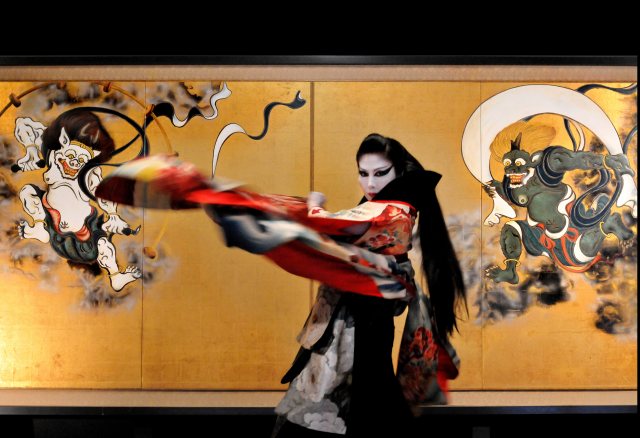
<Wind God / Thunder God>
It seems as if the dancer is guiding the two malevolent gods. While a beautiful image, at the same time tremendous power is shown.
The indigenous Japanese gods of Shinto are unruly, and to tame them was the earnest wish of the ancient people.
<Two Dragons>
A dragon is a symbol of fertility that brings a welcome rain in Japan. It was tied to water probably because it resembles a winding river just like Naga in India. So dragons are often drawn on the ceilings of temples as a charm of preventing fires. It is also considered as a guardian of Buddhism at temples. (It is probably because according to a legend in India, Naga believed devoutly in Buddhism hearing Buddha's sermon.) A dragon in Japan has a whole different concept from Western dragons.
These two dragons are drawn on the ceiling of a Buddhist temple, and the model got up on a stepladder while I was photographing on the floor.
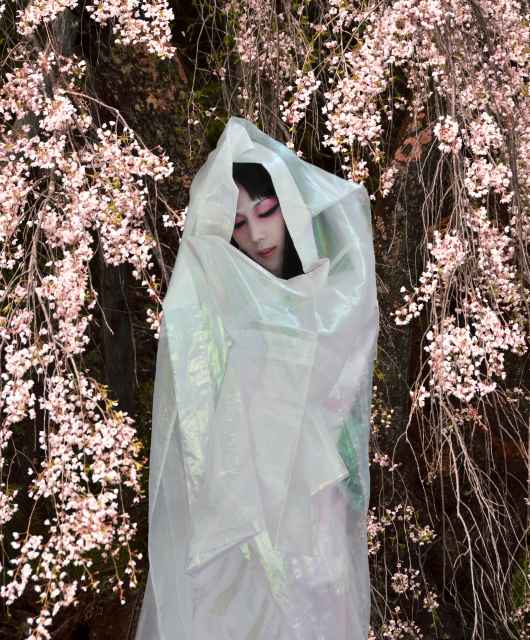
<Cherry Blossom・Cocoon>
This Cherry Blossom tree is over 600 years old. The large trunk is like a rock, though at the center, juvenescent life flows abundantly. A woman cocooned in silk stands as in a daze.
Is she is having the same dream as the ancient tree wrapped in time? Gold leaf applied with Japanese-style painting techniques represents the flickering of life.
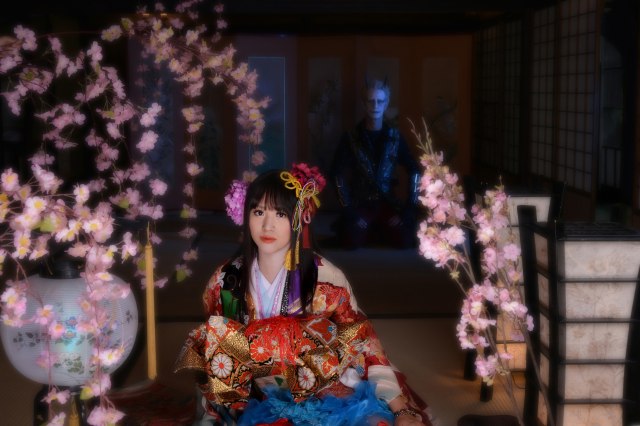
<Princess of the Cherry Blossoms at Night>
She has not realized yet that the "Hannya" is already in her room. This demon is the embodiment of grudge, jealousy, pain, and anger. Different light shines the demon to show it is from a different world, but it surely exists in the same room. The demon approaches her in response to the darkness in her mind, and it will consume her in the course of time. The only weapon that can destroy the demon and save her is not a rough sword used in a fight, but love of the hero, you.
This old Japanese house is where Ougai Mori, a famous writer, wrote his novel, "Maihime(A dancing girl, my princess)." There is a paper lantern used at "Obon" in front. "Obon" is a special festival held once a year in which souls of the deceased are said to return home. This paper lantern represents that the reality in which she exits is already leaning toward the world of the dead. The face of the man is not a mask but it is done with makeup.

< In a Garret>
A mask of a fox and girl's face appear white inside the dim warehouse. Was she forced in there or shut herself away? A bright future should be promised to the beautiful girl, but first she has to do something and deal with the darkness and the fox inside her.
A fox is a special animal in Japan. It is said to be a relation of God, and there are many Inari-jinja shrines that worship foxes and they mainly preside over thriving business. At the same time, there are superstitions about them bewitching humans and haunting humans making them lose their judgment and driving them mad, and there are a lot of sayings in Japanese. In any case, foxes are mysterious animals that remind us of sacred non-ordinary in Japan.
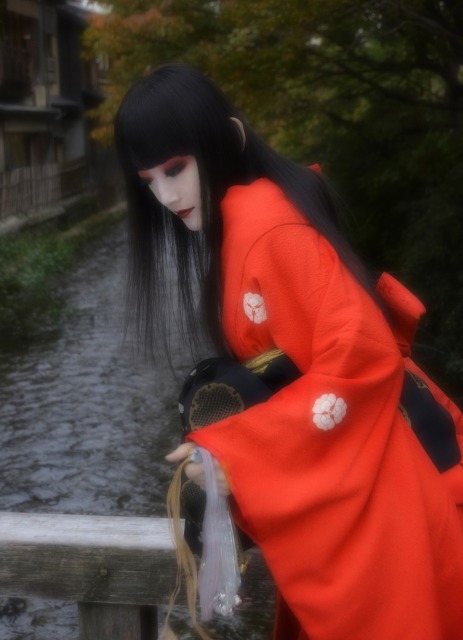
< Shirakawa>
Shirakawa is a small river that flows through Gion, the red-light district in Kyoto. Japanese-style restaurants line up along the river bank, and you can have refined Kaiseki-ryori, tea-ceremony dishes. When I was on the bridge over the river, I suddenly had the idea of expressing a traditional Japanese woman here. It is my fundamental image of an old-fashioned Japanese girl. The pose with flowing black hair was decided quickly, and I took several pictures.
The concept of her costume was "Kamuro," which is worn by girls before they become Tayu, or Oiran, high-class prostitutes. She has a bell with gold and silver ribbons, and they were used to announce the coming of a Tayu in her procession. An actual bell used in the procession had five-colored strings associated with Buddhism ideas.
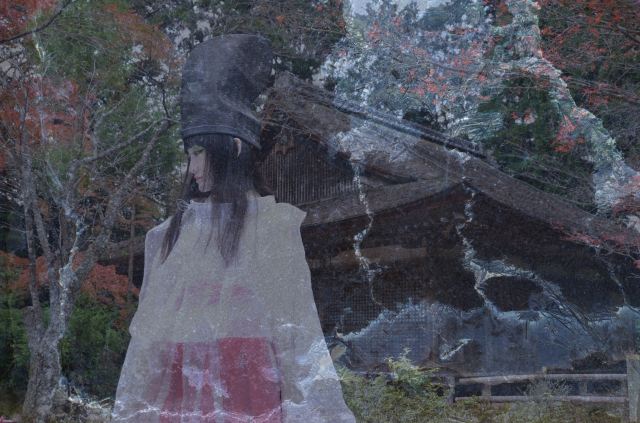
< a Memory of the years>
Where has the sorrow of Shirabyoshi gone? Where have her fine singing voice and her gaze gone? After the lapse of many years, how much time has passed?
Everything has disappeared over time, but Shirabyoshi's heart was stored as a fossil. I came in touch with a piece of this memory at the mountain temple. I saw an illusion of a Shirabyoshi through the model.Shirabyoshi is a wandering artist and prostitute in the 12th century. It was the time of wars and bloodshed in Japan then, so there were a lot of Shirabyoshis from noble families. They were often tossed around by men and their struggles for power, and some who had generals as their lovers suffered hard fate with them. They were girls dressed like men wearing hunting suits, Takaeboshis which were headgears worn by court nobles, and sometimes they carried long swords. They were said to have sung beautifully and danced elegantly.
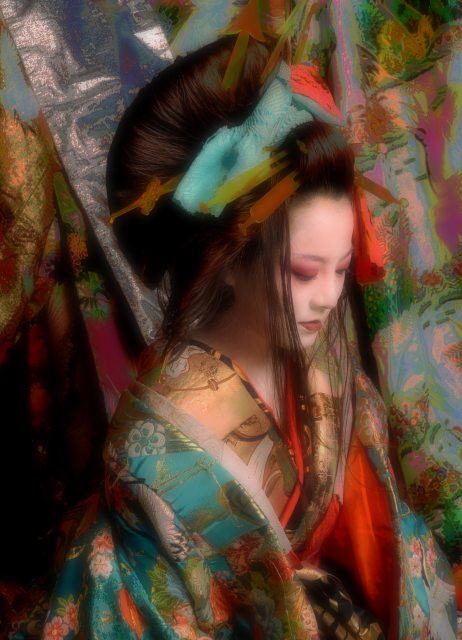
< Oiran>
With passing of time, Shirabyoshi became either Geiko or Geisha who specialized devotedly on entertainment, or Tayu or Oiran who were high-class courtesans. The highest rank of courtesan, "Tayu" had started in the 17th century, and it came to be called "Oiran" in Edo (today's Tokyo). High intelligence and excellent arts were necessary to be an Oiran, and not every courtesan but only the selected few could become one.
In today's Japan, there still are Geishas but not Oirans. A culture of Tayu still exists at Shimabara, Kyoto, but this is only for tourism and they show their accomplishments to tourists every day.

<Cherry Blossom・Awakening ― Spring ―>
The Cherry Blossom is the flower of Japanese peoples heart. During spring, every day television reports on the 'Cherry Blossom Front'. There is the riotous commotion of Cherry Blossom viewing (Hanami)in town parks. However, there are also trees that blossom unknowingly in mountainous areas, even ancient trees that continue blossoming quietly after hundreds of years.
Some thousand years ago, a young woman came across a grand tree, that blossoms beautifully to this day, opened her heart and greeted it. She knew the petals would fall before long.
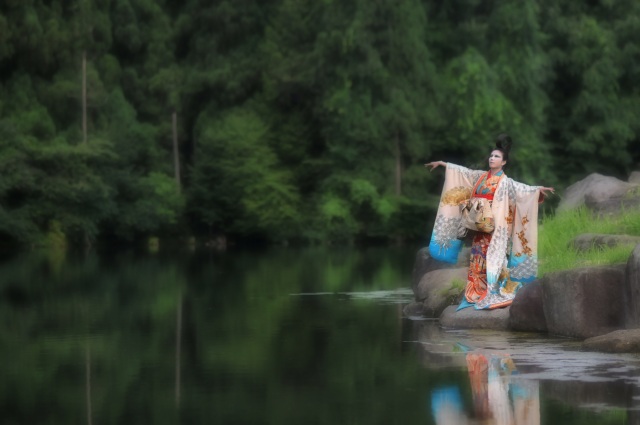
<Ancient Illusions ― Summer ―>
In my impression, ancient "butoh" is devoted to nature. A shrine maiden is in a trance, dancing calmly. A light breeze blows over the lake, making ripples and bringing inspirations for her.
<Morning has not come yet ― Autumn ―>
There was a "shirabyoshi(medieval Japanese dancer)" who had to set off on a journey early in the morning. When would she be able to come back to this capital?
Looking over her shoulder, precincts of a temple with tinted autumn leaves was quietly watching over her. Shirabyoshi danced her last dance and said goodbye to the temple that had supported her throughout her difficult and painful times.
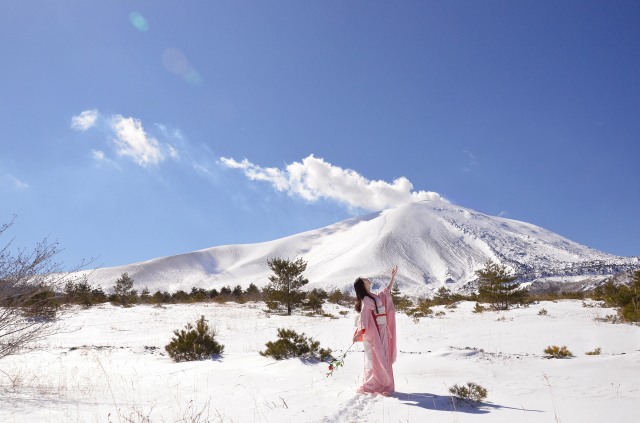
<Rebirth ― Winter ―>
Clouds over the snow-covered mountain are not actually clouds but smokes of the active volcano. With many volcanoes and earthquakes taking place in Japan, sometimes we fall victims to them. However, according to a legend, the phoenix rises from ashes of a volcano. Feeling the energy filled with hopes, let's offer the heavens the dance of rebirth, the dance of new lives.
photo:Naoya Yamaguchi---Model:Reika,Eriko,Rico Shirakawa,Etsuko Kanegae,Emi Ohtori
PROPOSAL
Diva's Japonism Project: A Window on Japan
translated by Dr.Hajime Terauchi
Outline of Project
The purpose of the visit is to rouse people's interest in Japan and to spread awareness of the distinct features of Japanese culture and aesthetics. There are five delegates altogether. They are Ms. Takagi as general coordinator, Dr. Terauchi as a lecturer specializing in the area of intercultural education, Ms. Yokomizo as a hairdresser, Ms. Terauchi as a dresser, and Mr. Yamaguchi as a photographer as well as a lecturer. The contents of this project are lectures on the pursuit of Japan's aesthetic sense through photos taken by Mr. Yamaguchi, including a lecture and a workshop by him in the first part of the session. The latter half of the session concentrates on practices and offers demonstrations on dress and hairstyles. A photo shoot of the participants dressing in kimonos is also included.
- 1.
- Objectives of the Project: To create an international exchange through the promotion of mutual understanding between Japan and international society. The purpose of this project is to let young people learn more about Japanese culture and aesthetics while raising their interest in Japanese culture and Japan itself. The project members are willing to present a workshop that should make participants gain a newfound appreciation of Japan. The project then aims at fostering knowledge and images of Japanese culture and Japan through cultural experiences.
- 2.
- Preparation
- ・
- Advance Preparations
- Distribution: Distribute a resume and put art works on "The Japonism" on display.
- ・
- Preparation of Materials
- An analysis based on the results of the questionnaires and feedback from the participants about the report is to be written. Sharing information with sponsors is also included.
- 3.
- Procedures
- First Half of Workshop
- ・
- Introduction: A survey on what is Japanese is given to the audience, who are assumed to have no prejudice.
- ・
- Visual explanation: Mr. Yamaguchi is to introduce his works by projector.
- ・
- Lecture: Explanation of background and purposes of works presented (traditional fine arts, customs, folktales, Japanese four seasons, nature, and animated culture, which is now considered a modern sub-visual culture), followed by a question-and-answer session.
- Latter Half of Workshop
- ・
- Practical experience: Participants in the workshop practice hairdressing and styling, building a reconstruction of models such as those shown in the "The Japonism" materials, and putting on a kimono properly.
- ・
- Explanation: An explanation regarding Japanese make-up and kimono is to be given, followed by a question-and-answer session.
- ・
- Photographing session: The project team will ask for volunteers to put on a kimono over their clothes and take a posed photo.
- ・
- Evaluation: Participants are to fill out a questionnaire.
- Results of the Questionnaire
- ・
- Distribution of photographs taken at the presentation immediately or at a later date
- ・
- Disclosure of the results of the questionnaire
- 4.
- Collaboration with Participants
- When participants visit Japan, the project team is to introduce Japanese culture to them (e.g., cultural exchanges through the Association of Japanese International Culture, of which Mr. Yamaguchi is a member; guided tours offered by volunteer students; intercultural exchanges among students of Takachiho University, where Dr. Terauchi belongs, members of JACET (Japan Association of College Teachers), and other intercultural practices.
- 5.
- Summary of Preliminary Preparation
- ・
- Preparation (April, 2005?January, 2012)
- Producing works on "The Japonism", Yamaguchi worked on the production of a group of works which may help people become aware of the Japanese four seasons. The author has continued working on various works by visiting, Kyoto's Heian Jingu Shrine in spring, in summer, Temple Jingo and Temple Joju, and others in Kyoto in winter; he was then engaged in the production of works in snow in Karuizawa, Nagano prefecture. In addition, Terauchi got involved in a project called "Moving Art Japan, English Project" in 2001. He held frequent workshops on physical expression in the field of education in Stratford-upon-Avon, England. Yamaguchi joined the project in 2010 when he photographed a poster.
- ・
- Preliminary Survey (June, 2011?March, 2012)
- Exhibitions held in the United Kingdom and Poland. Hearings in Italy (in the first half of the project period). "Moving Art Japan" promoted by Terauchi as part of British project in Stratford-upon-Avon and then offered as an exhibition and discussion session on Yamaguchi's works promoted by the education institutions of Stratford-upon-Avon and its Rotary Club in June, 2011. In September, 2011, offered workshops in Poland. Both the exhibition, including the discussion session, and the workshop attracted audience attention, at which point Yamaguchi was willing to seriously consider holding an exhibition of "The Japonism" in Europe.
- Yamaguchi and Takagai made a visit to Italy in March 2012 and held a hearing on exhibitions of "The Japonism" works at the Italian Japanese Embassy, Japanese Culture Center, and the University of Rome. Some suggestions given were the possibility of holding a lecture with the use of a projector instead of an exhibition as "The Japonism" works are regarded as art. The lecture then should be considered part of a cultural exchange with explanations. It could then be easier to take care of reservation of a site. Furthermore, a request from the University of Rome directly led to the proposal of this project. It was suggested that the project team hold a lecture for college students who belong to the Department of Japanese Studies there and that there was space enough to give an exhibition of works as well.
- 6.
- Participants
- The project aims to raise awareness and deepen people's understanding of Japanese culture and aesthetics. The project hopes to reach those who are interested in Japan, especially those who are young and have the potential to contribute to mutual exchanges between countries in the future.
- 7.
- Essence of Japanese Culture
- The main idea the team would like to express in its workshops is a sense of beauty and philosophy that is the widely acknowledged essence of Japanese culture. Japan has been considerably affected by different cultures from other countries as the terminal station of the Silk Road. Furthermore, Japan is an island country. Because of this distinguishing feature, Japan itself has been able to cultivate its own culture, taking time cutting and polishing its works.
For instance, a calm and vigorous sense of life exists in Jomom doki (pottery patterned by cords or straw rope), and Yamaguchi expresses this essence in his works "Pray" and "New Life (La Vita Nuova)." Similarly, Ocho literature (literature of dynasty) has its own graceful kindness and sensitivity, as seen in poems called "waka" (a traditional Japanese poetic form of thirty-one syllables). Yamaguchi embodies this form in "May God Stay under Flowers," "Inside the Godown," and "Secrecy of a Beam Dust." The following table shows works created by Yamaguchi.
Table Works by Yamaguchi
| Japanese Culture | Examples | Works |
|---|---|---|
| Magnanimity and a strong sense of vitality | Jomon (cord-marked pottery) | "Pray" "New Life (La Vita Nuova)" |
| Graceful kindness and sensitivity | Ocho literature (literature of dynasty) Waka (traditional Japanese poem of thirty-one syllables) Literature of Sorrow |
"May God Stay under Flowers" "Inside the Godown" "Secrecy of a beam dust" |
| Courage, respect, and purity | Bushi do (spirit of Bushi) | "God of Wind" "God of Thunder" |
| A keen observation of nature | Haiku Clear-polished beauty |
"Ancient Illusion" "Memories of Frost" |
| Philosophy that deepens relationships between ego and the world | Zen | "Cherry Trees" "Cocoon" |
| Belief in stillness and beauty of static forms | Noh Zeami |
"Dance of Snow" "Cherry Trees" "Cocoon" "Shirakawa" |
| Aesthetic and philosophy of ultimate hospitality | Tea ceremony, wabi and sabi | "A Break" |
| Grand formations and displays of characters | Pictures of birds, animals Hokusai (animated stories) Sharaku (modern animations) |
"Persona" "Shirabyoushi" (a courtesan) "Falling Flowers" "Paparachi" "Drums" |
| Reflection on the four seasons and contemplation of time | Kimono, Kaiseki (tea-ceremony dishes; a light meal served before a ceremonial tea) |
"Dance of Snow" "Morning Has Not Yet Come" "Under the Cherry Blossoms" "Memories of Stars and Frost" |
| Refined, pure style of dress and decoration | A garment with a long trailing skirt worn over a bride's kimono and obi Mannerism of Rin-school accessories, decoration |
"Colored Autumn" "All Sorts of Flowers (Spring Flowers)" |
| Free, plain composition | Ukiyoe (woodblock print) | "God of Wind" "God of Thunder" |
| Simple and horizontal directions | Mounting (Hyogu) and architecture, Katsura rikyu (Katsura Imperial Villa) |
"Soaring Time" "Kamuro" |
The sense of Japanese beauty described in the table above will be conveyed to people of other countries with impressive impact.
- 8.
- Summary of Project Stages
●First Stage
As for projections, the team is to use selected works by Yamaguchi called "The Japonism." The project aims at developing beautiful images of Japan as "Japan-like" into visual works that may have impact through the filter.
These visual projections should be images taken from the foundation that human beings share and should have a strong impact on those who have little professional knowledge of fine arts.
●Second Stage
Explanations and lectures are to be offered to show historical buildings, fine arts, philosophy, and the four seasons through the presented works. At the same time, participants are to be invited to a discussion session to talk about the cultural constructs of Japan and Italy or England.
●Third Stage
A practice of hairdressing and wearing kimonos is to be done. Participants are encouraged to join in for the exercise. It is expected that participants will vary in age and nationality. With careful observation of participants, workshops entitled "Workshop as a window on Japan" will be conducted.
●Fourth Stage: Assessment of Project Achievements
In order to evaluate the achievement of this project, the following are to be carried out:
・ Participants will fill out two questionnaires: one multiple-choice, the other descriptive.
・ A report will be written, analyzing the results of the questionnaires and presenting feedback from the promoters.
